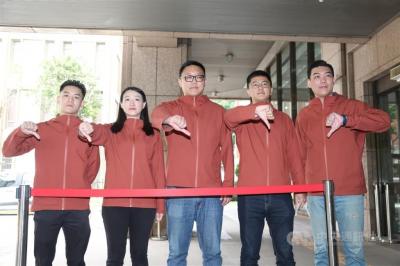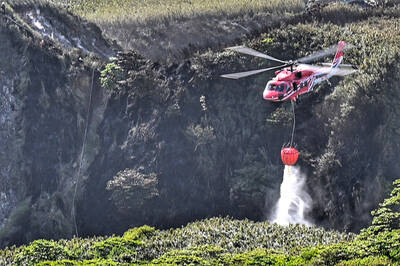The acid rain situation nationwide has improved markedly in the past decade, dropping to an incidence rate of about 53 percent during that period, the Environmental Protection Agency (EPA) said yesterday as it announced the results of a 20-year monitoring project.
The EPA said that while acid rain was a rare occurrence in the 1970s, it gradually became more serious in the 1980s, especially in northern parts of the country, as well as near Tainan and Kaohsiung. Acid rain monitoring efforts began in 1990, using pH levels below 5 as a benchmark for acid rain, it said.
Hsieh Yein-Rui (謝燕儒), director-general of the Department of Air Quality Protection and Noise Control, said there are 12 acid rain monitoring stations scattered across the country, adding that data collected from 1999 through this year showed an average acidity level of pH 5.02.
Instances of acid rain remain more common in the north than in the south, it added.
Peng Chi-Ming (彭啟明), co-organizer of the research project and an assistant professor in atmospheric sciences at National Central University (NCU), said acid rain tended to occur more in the spring and fall when the northeast monsoon brings air that is laden with particulates.
The area surrounding Jhongli (中壢), Taoyuan County, has the worst acid rain problem in the nation, with an incidence rate of 75 percent.
About 100 percent of the rain that fell in that area during winter was acid rain, Peng said.
The two principal causes of acid rain in Taiwan are polluted air from abroad — mainly China — and local pollution, said Lin Neng-huei (林能暉), co-organizer of the project and professor of atmospheric sciences at NCU, adding that the two were equally responsible.
However, fog can be more acidic than rain because it contains less water and a higher density of acidic substances, Peng said.
A lot of people fear that being exposed to acid rain will cause baldness, Peng said.
“Actually, getting rained on by acid rain is more of a long-term problem ... if you are exposed to it every day, then eventually it can cause some harm,” Peng said.
Hsieh said the EPA would continue to enforce regulations to control air pollution, as well as communicate with China on the technical aspects of controlling the problem.

Taiwan is stepping up plans to create self-sufficient supply chains for combat drones and increase foreign orders from the US to counter China’s numerical superiority, a defense official said on Saturday. Commenting on condition of anonymity, the official said the nation’s armed forces are in agreement with US Admiral Samuel Paparo’s assessment that Taiwan’s military must be prepared to turn the nation’s waters into a “hellscape” for the Chinese People’s Liberation Army (PLA). Paparo, the commander of the US Indo-Pacific Command, reiterated the concept during a Congressional hearing in Washington on Wednesday. He first coined the term in a security conference last

Prosecutors today declined to say who was questioned regarding alleged forgery on petitions to recall Democratic Progressive Party (DPP) legislators, after Chinese-language media earlier reported that members of the Chinese Nationalist Party (KMT) Youth League were brought in for questioning. The Ministry of Justice Investigation Bureau confirmed that two people had been questioned, but did not disclose any further information about the ongoing investigation. KMT Youth League members Lee Hsiao-liang (李孝亮) and Liu Szu-yin (劉思吟) — who are leading the effort to recall DPP caucus chief executive Rosalia Wu (吳思瑤) and Legislator Wu Pei-yi (吳沛憶) — both posted on Facebook saying: “I

Sung Chien-liang (宋建樑), who led efforts to recall Democratic Progressive Party (DPP) Legislator Lee Kun-cheng (李坤城), was released on bail of NT$80,000 today amid outcry over his decision to wear a Nazi armband to questioning the night before. Sung arrived at the New Taipei District Prosecutors’ Office for questioning in a recall petition forgery case last night wearing a red armband bearing a swastika, carrying a copy of Adolf Hitler’s Mein Kampf and giving a Nazi salute. Sung left the building at 1:15am without the armband and covering the book with his coat. Lee said today that this is a serious

A mountain blaze that broke out yesterday morning in Yangmingshan National Park was put out after five hours, following multi agency efforts involving dozens of fire trucks and helicopter water drops. The fire might have been sparked by an air quality sensor operated by the National Center for High-Performance Computing, one of the national-level laboratories under the National Applied Research Laboratories, Yangmingshan National Park Headquarters said. The Taipei City Fire Department said the fire, which broke out at about 11am yesterday near the mountainous Xiaoyoukeng (小油坑) Recreation Area was extinguished at 4:32pm. It had initially dispatched 72 personnel in four command vehicles, 16